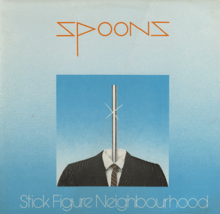Stick Figure Neighbourhood
Stick Figure Neighbourhood was the first album by the Burlington band Spoons. Released in 1981, it received some airplay on went to the top of the Canadian University radio charts[1][2] (specifically with songs "Conventional Beliefs" and "Red Light"), but it was their next album, Arias & Symphonies – and its best known single, "Nova Heart" – that were to launch them to fame.
| Stick Figure Neighbourhood | ||||
|---|---|---|---|---|
 | ||||
| Studio album by | ||||
| Released | 1981 | |||
| Recorded | February 1981 | |||
| Studio | Grant Avenue Studios, Hamilton | |||
| Genre | New wave | |||
| Length | 41:54 | |||
| Label | Ready Records | |||
| Producer | Graeme Pole | |||
| Spoons chronology | ||||
| ||||
This album was recorded by Daniel Lanois at the Grant Avenue Studios in Hamilton, Ontario. Its liner notes collectively thank fellow contemporary Toronto bands The Diodes, Martha and the Muffins, and concert promoter Gary Cormier of "The Garys".[3]
As Gordon Deppe mentions in his liner notes for Collectible Spoons, this collection of songs "is a bit rough around the edges, but there are things on it that [are] still very interesting and perplexing."
Background
Stick Figure Neighbourhood was partly inspired by the band's interest in progressive rock, where an emphasis is placed on creating atmospheres as opposed to rhythms. Another inspiration was the show The Prisoner, where songs such as "Dropped Dishes" and "Capitol Hill" reflect situations the show's protagonist No.6 would go through.[4]
"After the Institution" (b/w "My Job") from 1980 was an early song from the group that was left off the album due to the feeling that it was "too new wave". Regardless of the decision, the album still manages to be full of synthesizers, "raunchy" guitars, and pounding drums, all while being held together by Horne's bass.[4]
The track "Ice Age" was originally called "Elephant's Graveyard" but was changed due to the Boomtown Rats' song of the same name. Deppe states that the imagery of "glaciers moving along" are present in both songs. He goes on to explain that – after reading the story on the back cover of Genesis Live – he got the inspiration for "Stick Figure Neighbourhood". The image on the album cover reflects this idea, along with the notion of a typical suburb.[4]
Reception
Despite the album's lack of singles and placement on any mainstream chart, Stick Figure Neighbourhood was well-received by the media. Journalists wrote how the album was "one of the most imaginative debut discs to appear in a long time"[5] and that the band had achieved "an exhilarating blend of textural...melodies, brittle bass lines, rhythmic guitar riffs, and consistent percussion".[1] Many already began to believe that this album was the beginning of the band's bright career.
Track listing
| No. | Title | Writer(s) | Length |
|---|---|---|---|
| 1. | "Conventional Beliefs" | Deppe | 3:57 |
| 2. | "Stick Figure Neighbourhood" | Deppe, Horne | 3:59 |
| 3. | "Red Light" | Deppe | 4:42 |
| 4. | "For Tran" | Deppe | 3:42 |
| 5. | "Capitol Hill" | Deppe | 4:38 |
| 6. | "Ice Age" | Horne, Deppe | 4:07 |
| 7. | "Dropped Dishes" | Deppe | 3:56 |
| 8. | "Friends in the Media" | Deppe | 3:31 |
| 9. | "Only for Athletes" | Deppe | 5:28 |
| 10. | "Annita" | Deppe | 4:16 |
Personnel
Musicians
- Gordon Deppe - vocals, guitar
- Sandy Horne - bass guitar, pedals, vocals
- Rob Preuss - synthesizer, piano
- Derrick Ross - drums, percussion
Production
- Graeme Pole - producer
- Daniel Lanois - recorded by
References
- Noble, Peter (10–16 December 1981). "Spoons For Your Ears". Spoons Official Site/Darrin Cappe. Retrieved 12 April 2019.CS1 maint: date format (link)
- Gross, Jonathan (21 January 1982). "Punter Bends Spoons Into A New Shape". Spoons Official Site/Darrin Cappe. Retrieved 12 April 2019.
- "Stick Figure Neighbourhood". Spoons Official Site/Darrin Cappe. Retrieved 12 April 2019.
- Burman, Terry (November–December 1981). "Records". Spoons Official Site/Darrin Cappe. Retrieved 12 April 2019.CS1 maint: date format (link)
- "Young Band With A Future". Spoons Official Site/Darrin Cappe. Oct 1981. Retrieved 12 April 2019.